The proliferation of heavy e-bikes and cargo bikes has created a strong need for assisted-lift workstands in bike shops around the world. These assisted stands, offered by the likes of Park Tool, Unior, VAR, and Efficient Velo Tools, are built and priced accordingly for the busy professional shop. And even if you could afford one for a smaller business or dream home workshop, most of the designs demand significant space and aren’t so easy to move.
Launched last year, American-based Remco Tools was the first to bring the hands-free bike lifting of an electric stand into a compact and surprisingly affordable package (pricing from US$595). And while getting a heavy bike off the ground without risk of injury is the big selling feature, my longer-term testing over the past nine months has shown such a height-adjustable stand offers a lot more benefit than that.
Good stuff: Modular design intended to bring new life to thousands of popular workshop stands, incredibly reliable, simple operation, as solid-feeling as a fixed height stand, plug-and-play design, a whole lot of stand for the money, overbuilt for claimed weight capacity, compact design, height adjustment is a super handy feature.
Bad stuff: More limited total height range than larger (and more expensive) professional options, no load sensor so care is needed in lowering bike, provided clamp chuck lacks clamping force, power cable moves with height adjustment, not suggested for long wheelbase cargo bikes.
Intro to Remco's Bike Lift
A decent workstand is a necessity for any professional bike mechanic and also forms a rather central piece for any home mechanic, too.
The story of Remco is that one of its founders had a back injury and was struggling to comfortably lift their bike into a workstand. It just so happened that this founder was one of the designers behind a leading electric-lift standing desk and quickly started to research whether that tech could help solve the issue of lifting a bike in a more affordable way.
Fast-forward a couple of years, and the company of two made its first public appearance at the inaugural 2023 MADE Bike Show with a polished-looking electric-lift workstand. Featuring a telescoping centre column and basic control panel, this workstand took the same floor footprint as a traditional Park Tool PCS-3-style shop stand and aimed to be a direct replacement for the centre column of those stands, too.
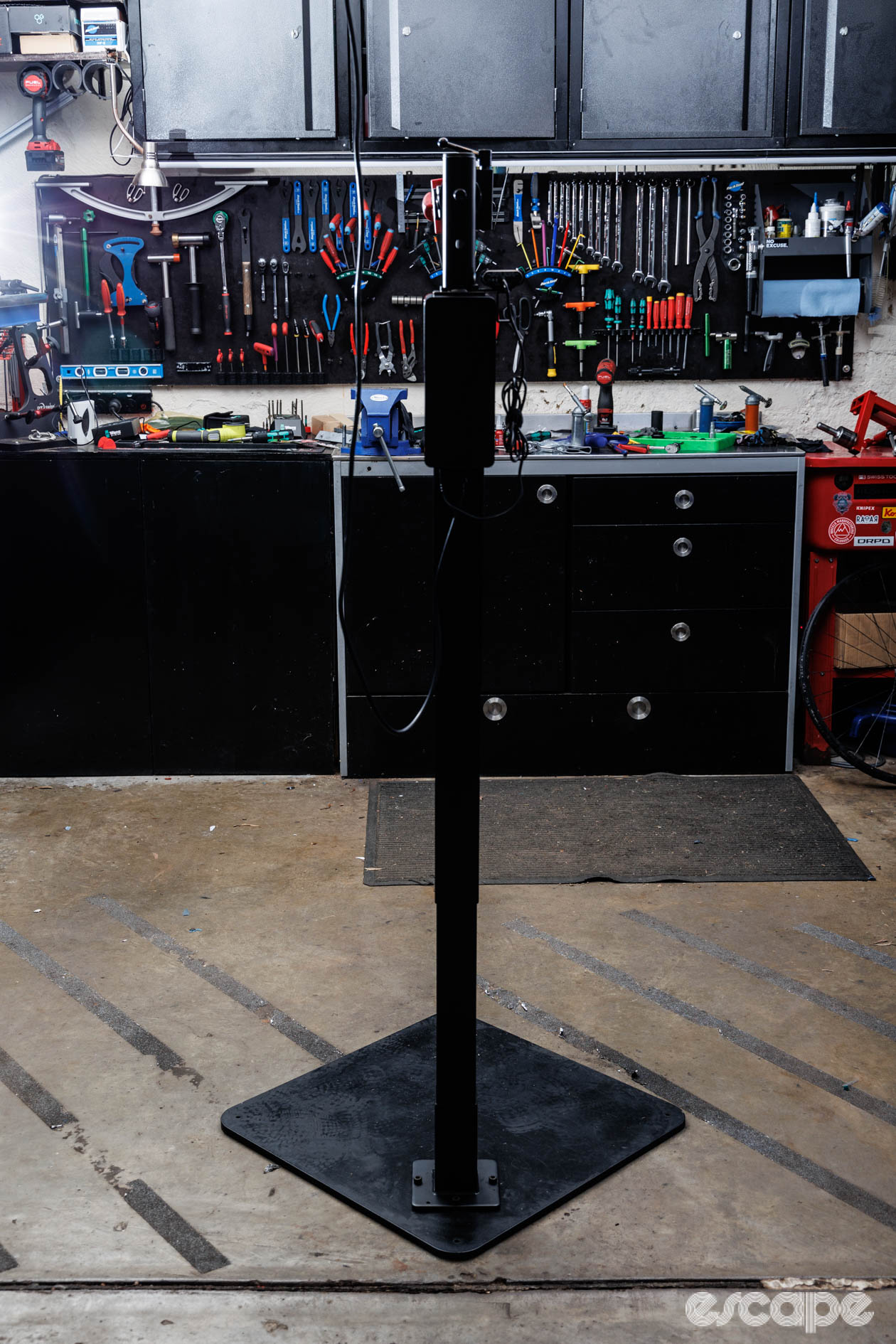
Multiple generations of Park Tool PRS-3 workstands are a bread-and-butter item from the blue tool company and remain a staple in bikes shops around the globe. Built with a steel centre column, these stands can be bolted to the floor or mounted to a hefty steel base. They offer a quality clamp and smooth angle adjustment. They’re effectively bomb-proof. They’re priced where just about any professional operation can justify the expense (approx US$635), and I know a number of home mechanics who have treated themselves to them, too. However, while the latest versions do offer some level of height adjustment, it’s certainly not going to help lift or lower a bike.
Remco’s modular design borrows Park Tool’s four-bolt pattern for bolting it directly to a floor or mounting it to a heavy steel base – whether Park Tool’s or Remco’s own. At the centre of Remco’s creation is a powder-coated telescoping column with an electronic control box. On top of that you’ll find another four bolt holes for mounting a post that can be used with either the 2" chuck adapter from a Park Tool PCS-3-style stand, Remco’s own equivalent chuck adapter, or the whole clamp assembly off a number of Feedback Sports’ folding stands.


If using Remco’s or Park Tool’s 2" chuck adapter, you can then fit workshop-style clamps from Park Tool, Feedback Sports, or EVT. These workshop-style clamps all feature a 2in cylinder for where they fit into the chuck adapter and Remco has a compatibility list on its website. Remco is also working on its own clamp, something it hopes will be ready in a few short months and may even help to make the complete stand package even cheaper.
If you already own a suitable stand or clamp then Remco will sell you fewer required parts, or if you need everything, that’s an option, too. For example, if you already own a Park Tool PCS-3 type stand, then for US$595 you can upgrade it to be an electric-assist workstand suitable for professional usage. Or if you’re in the market for a whole new workstand, then complete options are available from US$694 without a clamp, US$914 with a Feedback Sports Pro Elite Commerical clamp, or US$1,164 with the addition of the steel base. While the company is based in the US and offers free domestic shipping within the Lower 48 States, Remco also has local distribution in Australia (AU$1,800 for the whole package), some European countries, and ships direct to many other markets.
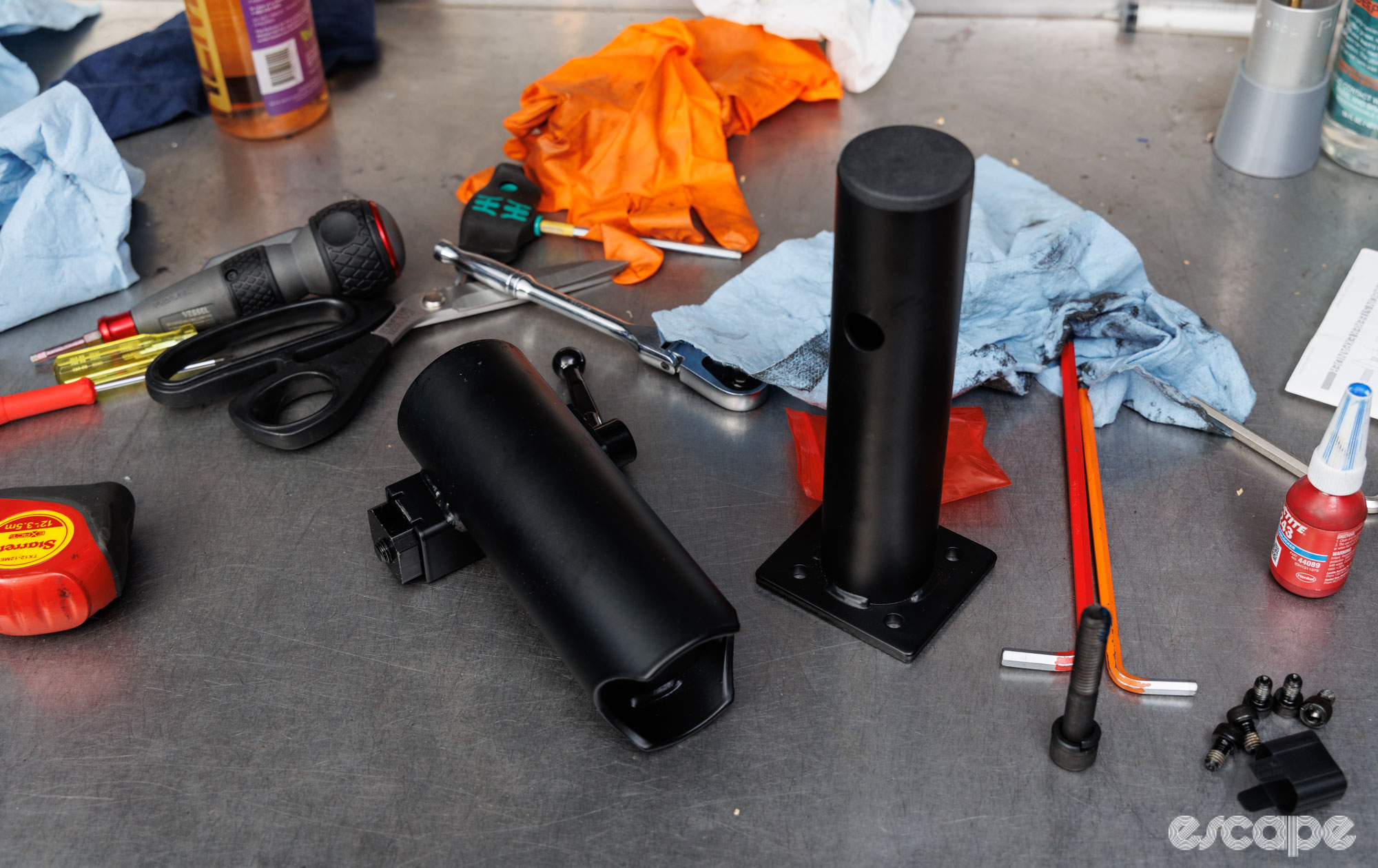
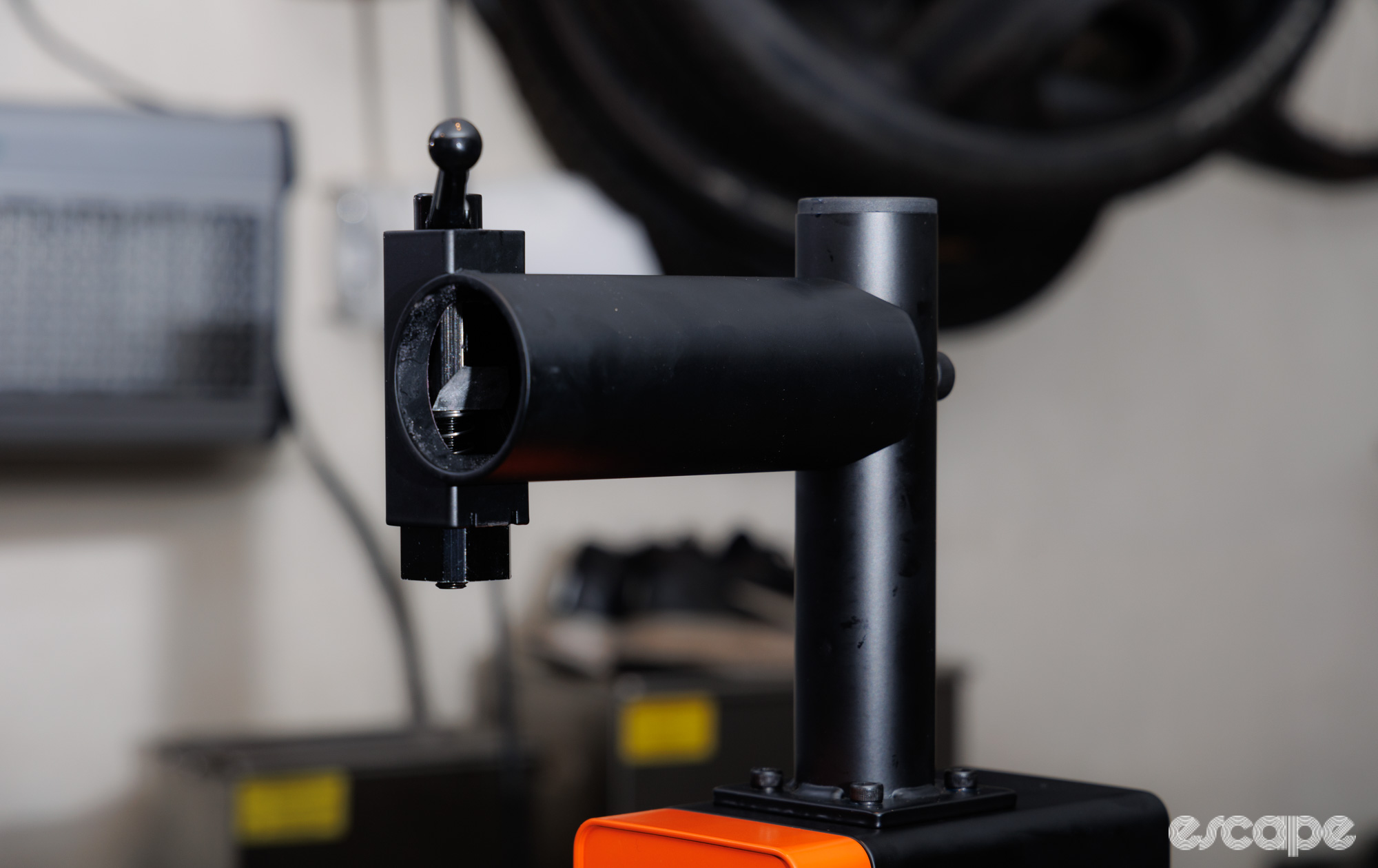
Details
The Remco Bike Lift uses similar tech to the standing desks the founders had previously succeeded with. Internally you’ll find a linear actuator motor that runs a hefty steel lead screw. The design is wonderfully simple, with the electric motor only used to adjust the height and not hold it in place. Given this, it is possible to use the stand unplugged once set to a preferred working height.
Officially the Bike Lift has a lifting capacity of 45 kg (100 lbs). That figure is playing it plenty safe, with the stand showing no signs of slowing, increased noise, or faults at that maximum figure. Remco themselves tested a stand for over 25,000 full height cycles with 45 kg before going into production. According to Remco, that’s enough to be used every 30 minutes, seven days a week, for eight hours a day for 4.25 years and without any service intervention. The stand carries a five-year warranty.
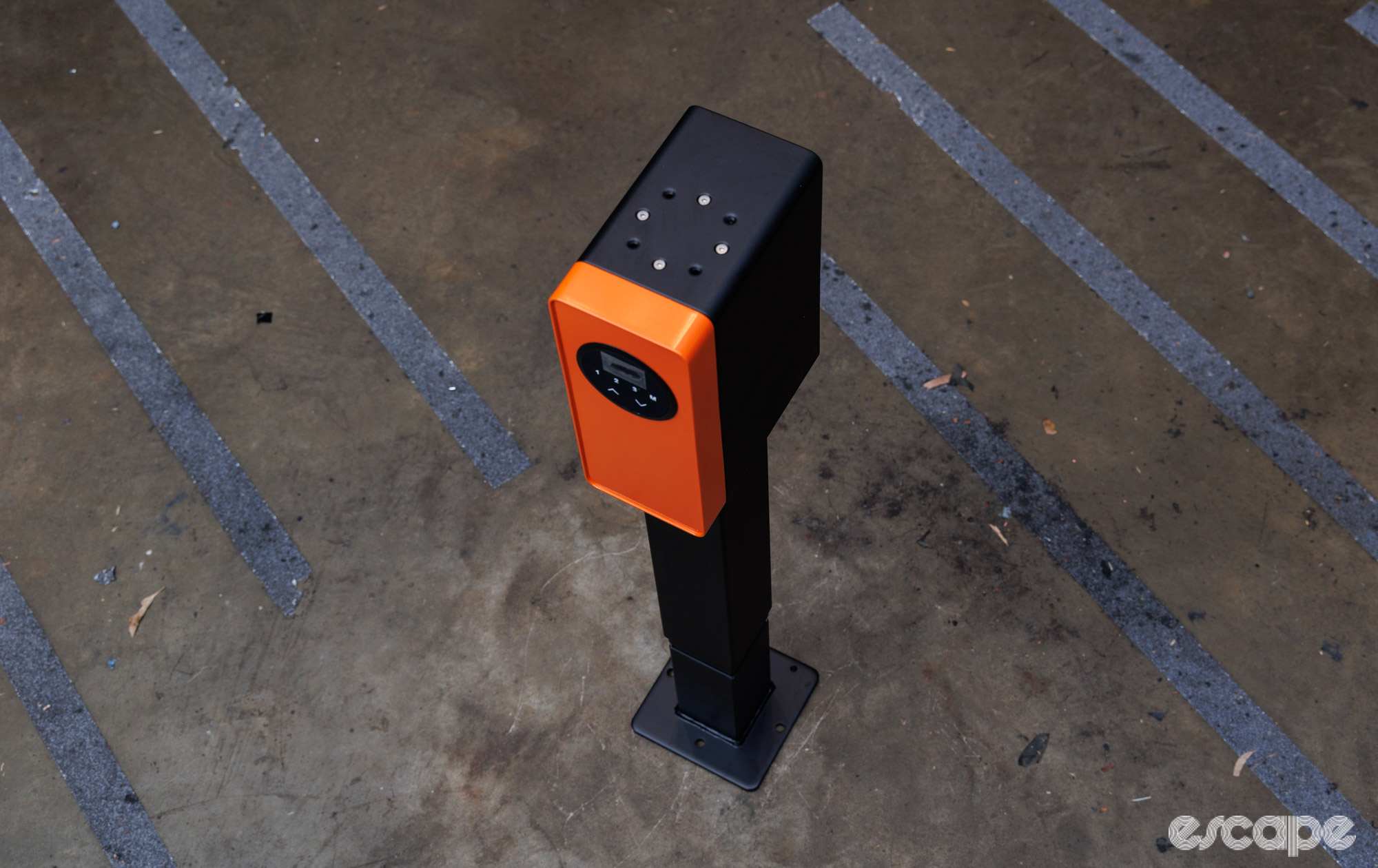
Don't try this at home, but I ignored the quoted capacity by sitting my 72 kg (158 lbs) frame directly on top and going for a ride. The stand took me to the ceiling and back without any obvious groaning or moaning (it did, however, go into overload protection on the second attempt. More on this later).
Either way, it’s certainly capable of lifting regular bikes, heavy e-MTBs, and pannier-laden bikes. However, Remco does warn against lifting long-wheelbase cargo bikes where the increased leverage (or off-centre weight distribution) of such things can cause the stand to topple, and perhaps load the centre column in ways it wasn’t intended. The same warning applies to most other shop stands using a regular-sized steel base, and certainly to those with folding legs.
With a straight-arm clamp such as a Park Tool or Feedback Sports in place, the stand offers a minimum and maximum height of 85 and 149 cm respectively (33” to 59”, measured from the base plate to the centre of clamp jaws). By comparison, the latest Park Tool PCS-3.3-2 can be adjusted between 121 and 151 cm (47" to 59").
Sitting conveniently below the clamp area is the simple six-button control panel with a number-based LCD screen. A byproduct of this enclosed design means the C13 power cord sits at the bottom of this control box and moves with the stand. Remco provides a bungy-style power cord (with the appropriate plug for your region of purchase) and some matching cable-guiding loops to keep things clean, but you’ll still need to run the cord along the floor to a nearby outlet, or as I did, from the ceiling above.

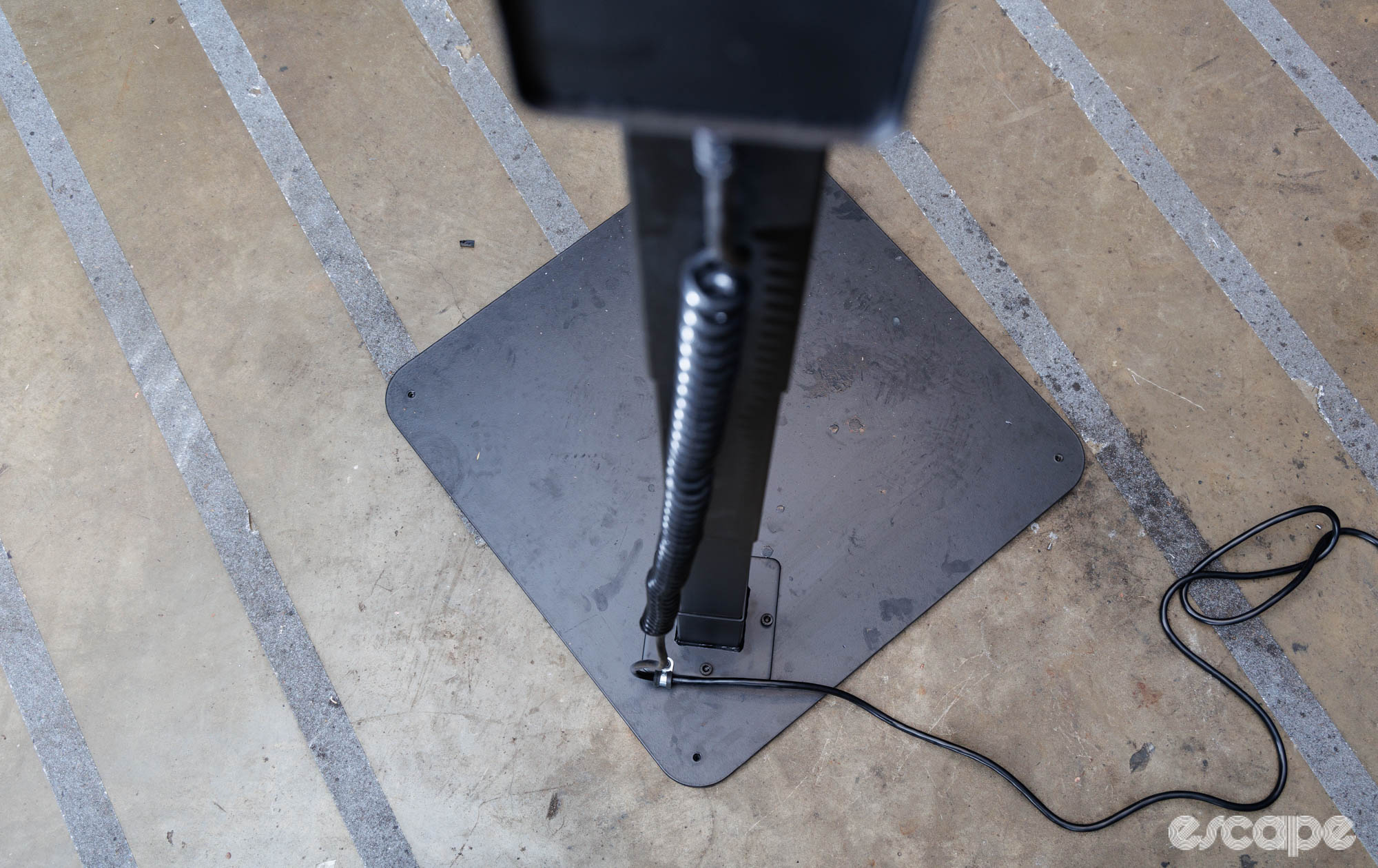
Alongside the power cord receptacle sits a two-pin Molex connector. While currently not available from Remco, the company has been testing the optional add-on of a USB dock that allows for easy charging of things on bikes.
The front panel of the control unit meets IPX4 standards (it'll resist splashes of liquid) and it seems unlikely any aerosol-based product or degreaser from a chain-cleaning tool will find its way into the stand. That said, the backside of the unit isn’t waterproof and so, like other electric-assist stands, it’s not the right tool for a full bike wash.
Shop stands aren’t intended to be easily moved, but with the plug pulled, I found I could swing this stand out of the way with no more difficulty than the Park Tool PCS-3. Remco’s sealed column/unit weighs 10.9 kg (24 lb). At 58.5 x 58.5 cm and 29.5 kg (65 lbs), Remco's steel base is a bit larger and heavier than Park Tool’s “130” Repair Stand Base and it almost gave the FedEx delivery guy a hernia. Worthy of note: if you need a base, Remco’s is nicer than the compatible Park equivalent, offering a smoother finish and adjustable levelling screws for uneven flooring.
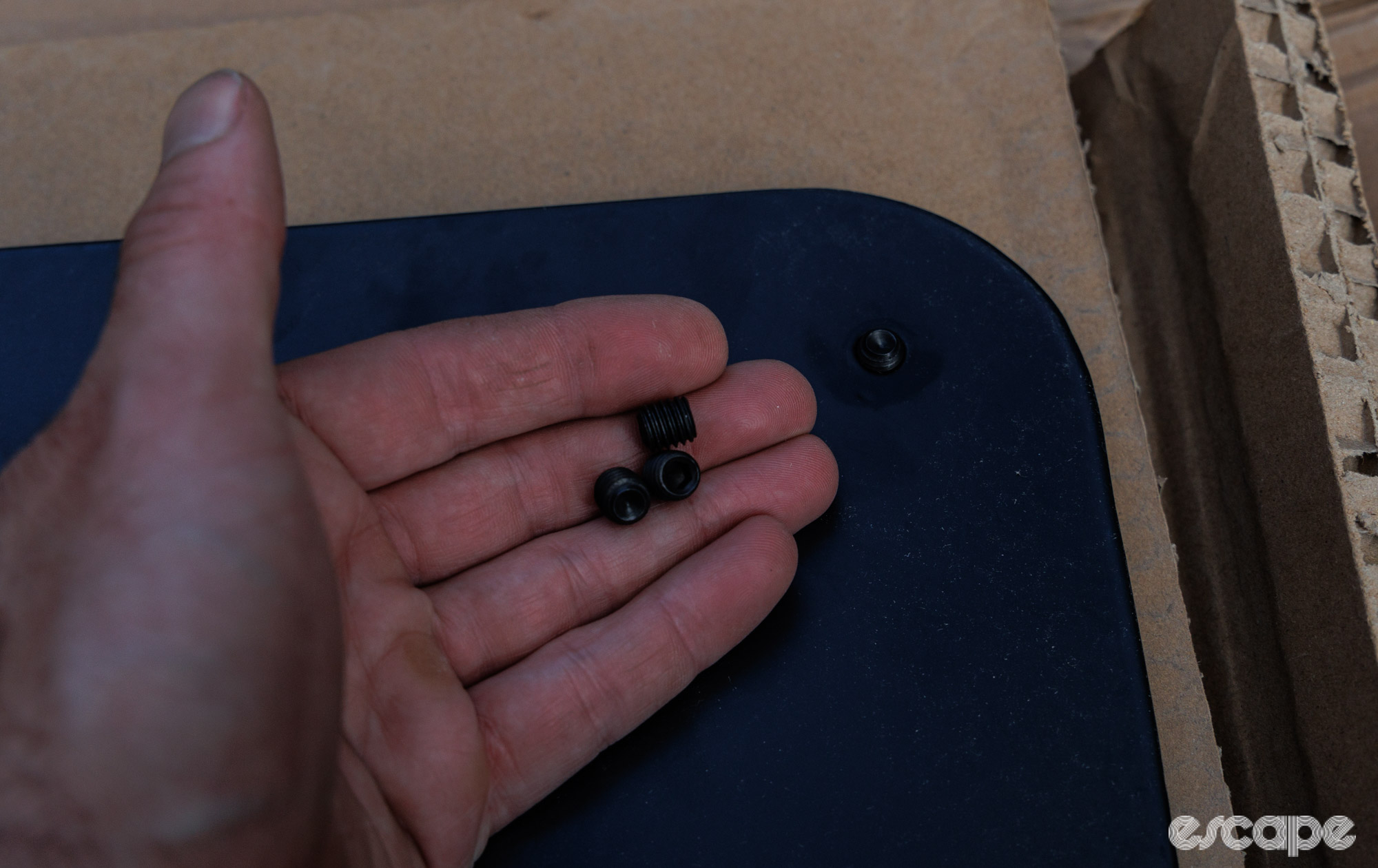
You raise me up
In a sea of competitors who will ship you enormous packages that require detailed assembly, getting the Remco stand up and moving couldn’t be simpler. The unit arrives ready to bolt to the floor/base (four metric bolts), to have the clamp adapter attached (five metric bolts), and to be plugged into an outlet. Truly the hardest part is figuring out how to run the power cable so you won’t trip on it.

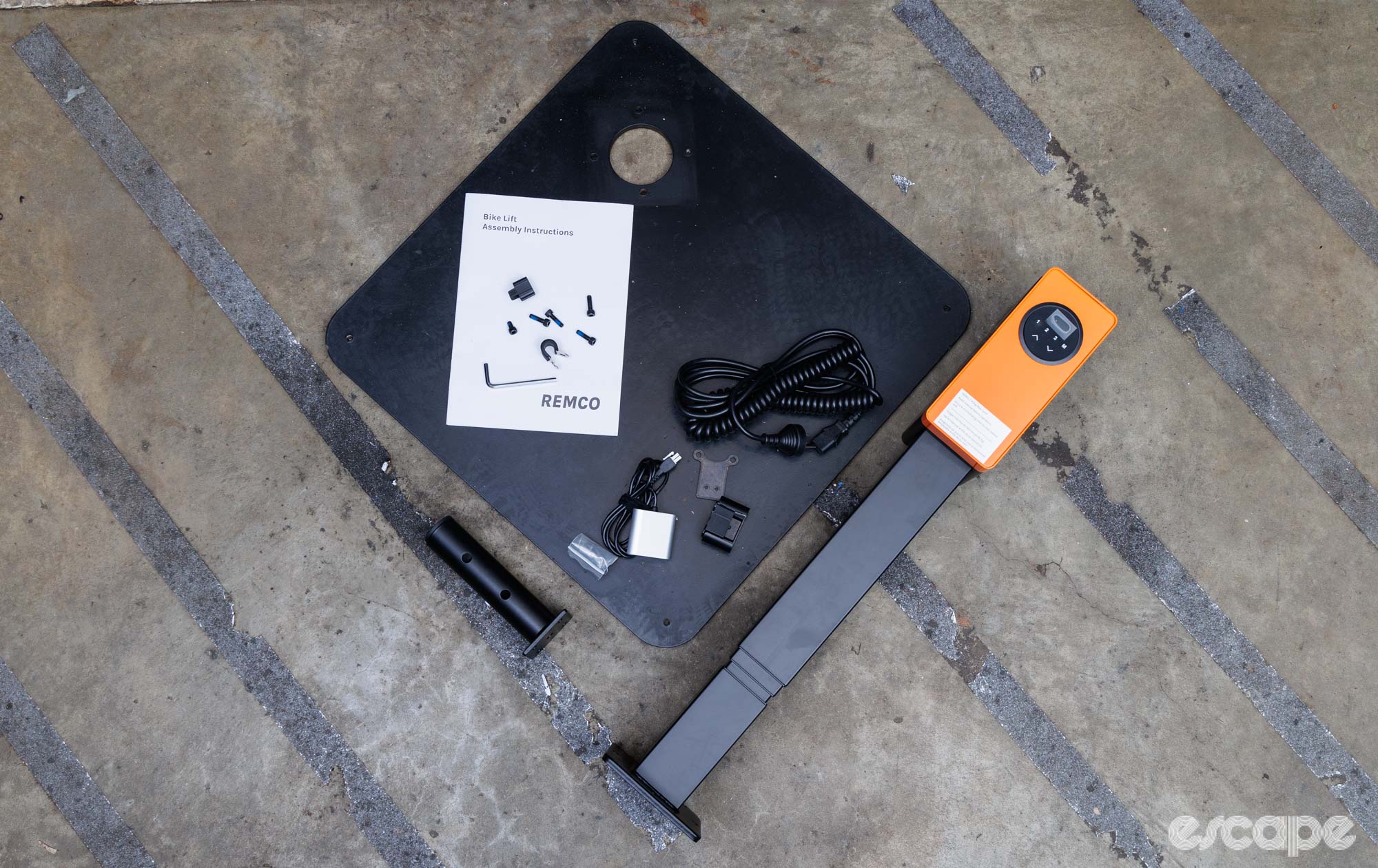
The simplicity continues in using the six-button control panel. The larger up and down arrow buttons allow you to adjust the stand by a simple press-and-hold. On top of that sit the “1, 2, and 3” preset height buttons along with a memory button. Those three preset buttons can be configured to put the stand at whatever height you want, and for me, I have them set to take a bike to the minimum height, the maximum height, and my preferred working height of 164 cm (achieved with an EVT Right Arm clamp).
Given the compact form factor, it shouldn’t be surprising that the Remco stand's maximum height is more limited than that of other professional workshop lift-assisted stands from EVT, Park Tool, VAR, and Unior. Still, it is significantly taller than most portable-type workstands and should be amply comfortable for the majority of users, although the tall will likely benefit from the additional height an EVT Right Arm clamp adds.
That small form factor would have you thinking the minimum height is then without issue, but alas, I found it just that little too tall to easily mount some lower-set bikes with both wheels firmly on the ground. Still, lifting a rear wheel by 15-20cm (or placing it on a step-stool) in order to clamp it is certainly still a whole lot easier than hoisting a whole bike to chest height. Alternatively, you can achieve that extra low depth by using an EVT Right Arm clamp upside down. Either way, this stand left me lusting for the ability for all bikes to be lowered to the ground like what the other professional workshop lift-assisted stands offer.
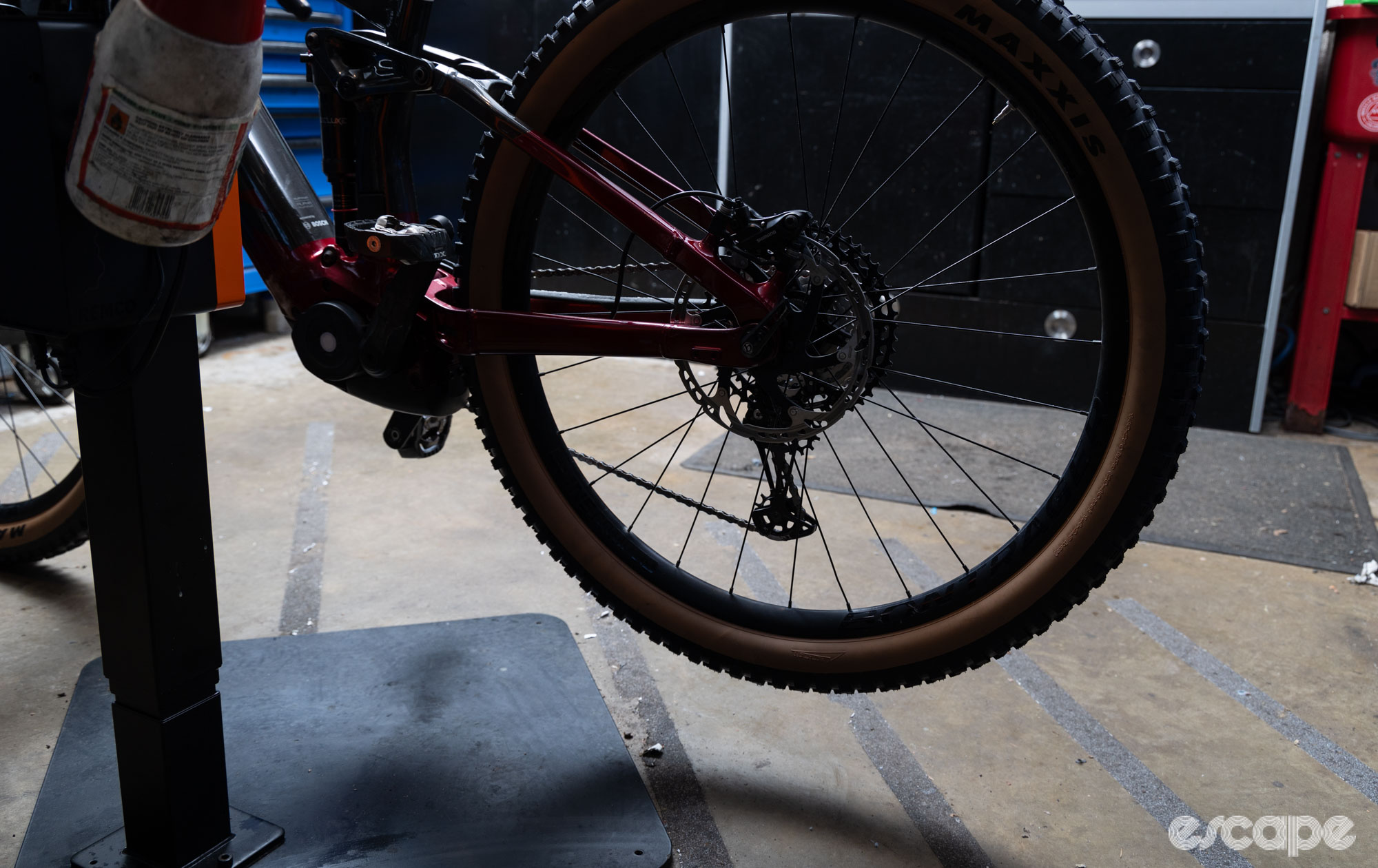
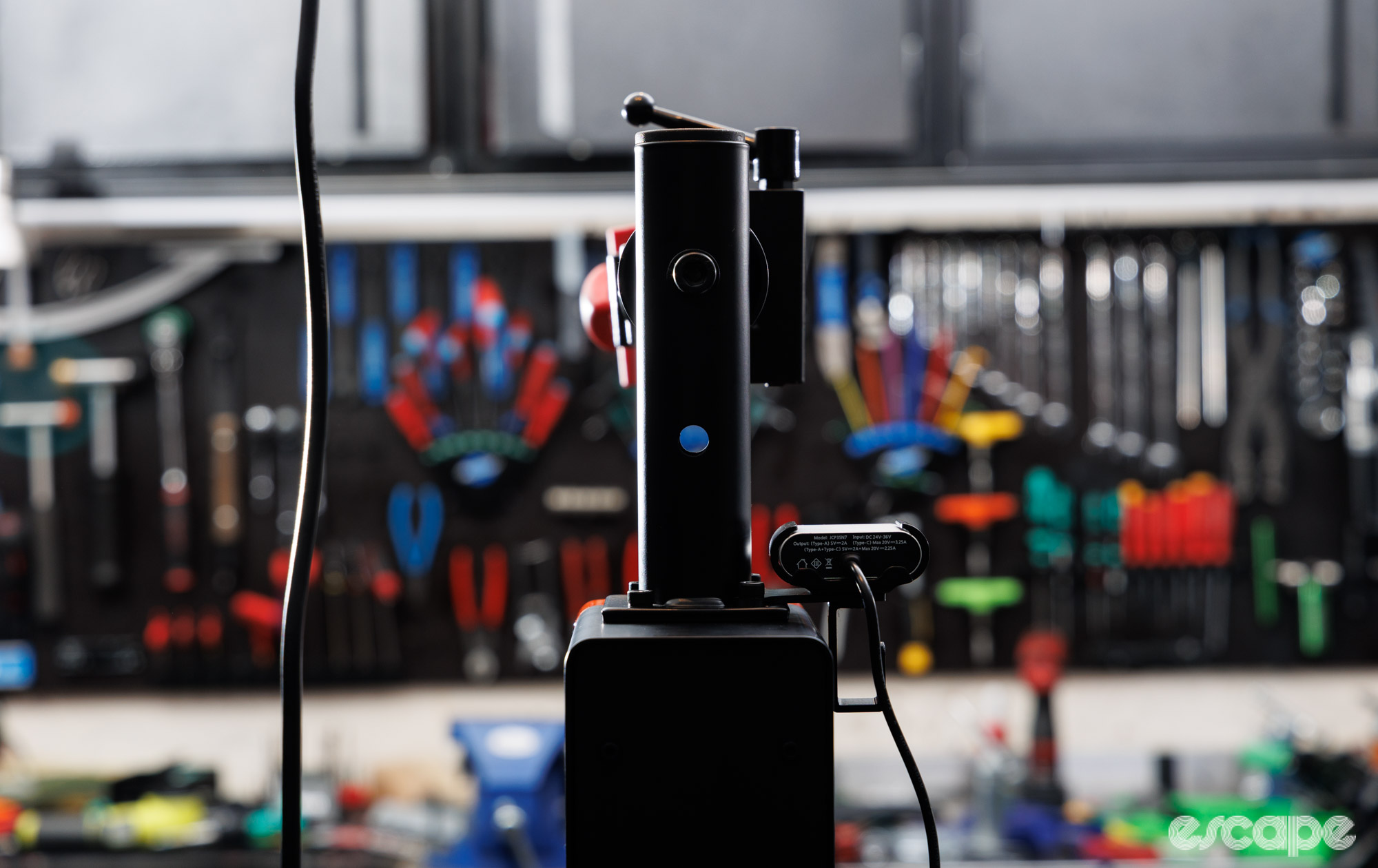
It should be obvious why an assisted-lift stand is beneficial when dealing with heavy bikes, but I didn’t fathom how often I’d use the height-adjustment setting in regular wrenching on lighter bikes. Here, I could quickly adjust the height of a bike to keep a loose fork propped up on a rolling stool or adjust the height of the bike so that I could easily peer into the top of a brake bleed cup while still having the handlebars pointed skyward. It’s certainly a luxury, but one I found greatly beneficial.
The stand doesn’t move at a rapid pace, but it’s quick enough to travel through its full height range in 15 seconds. That’s speedy enough for me to clamp a bike at the lowest height, push a preset button, grab the tool I need to begin, and have the bike at the desired height waiting on me.
Loading up the stand with a heavy e-bike doesn’t seem to slow it down at all, and there’s no increase in motor noise or the like. Speaking of noise, the stand emits something, but it hardly registered amongst the surrounding 45-50 dB ambient sound.
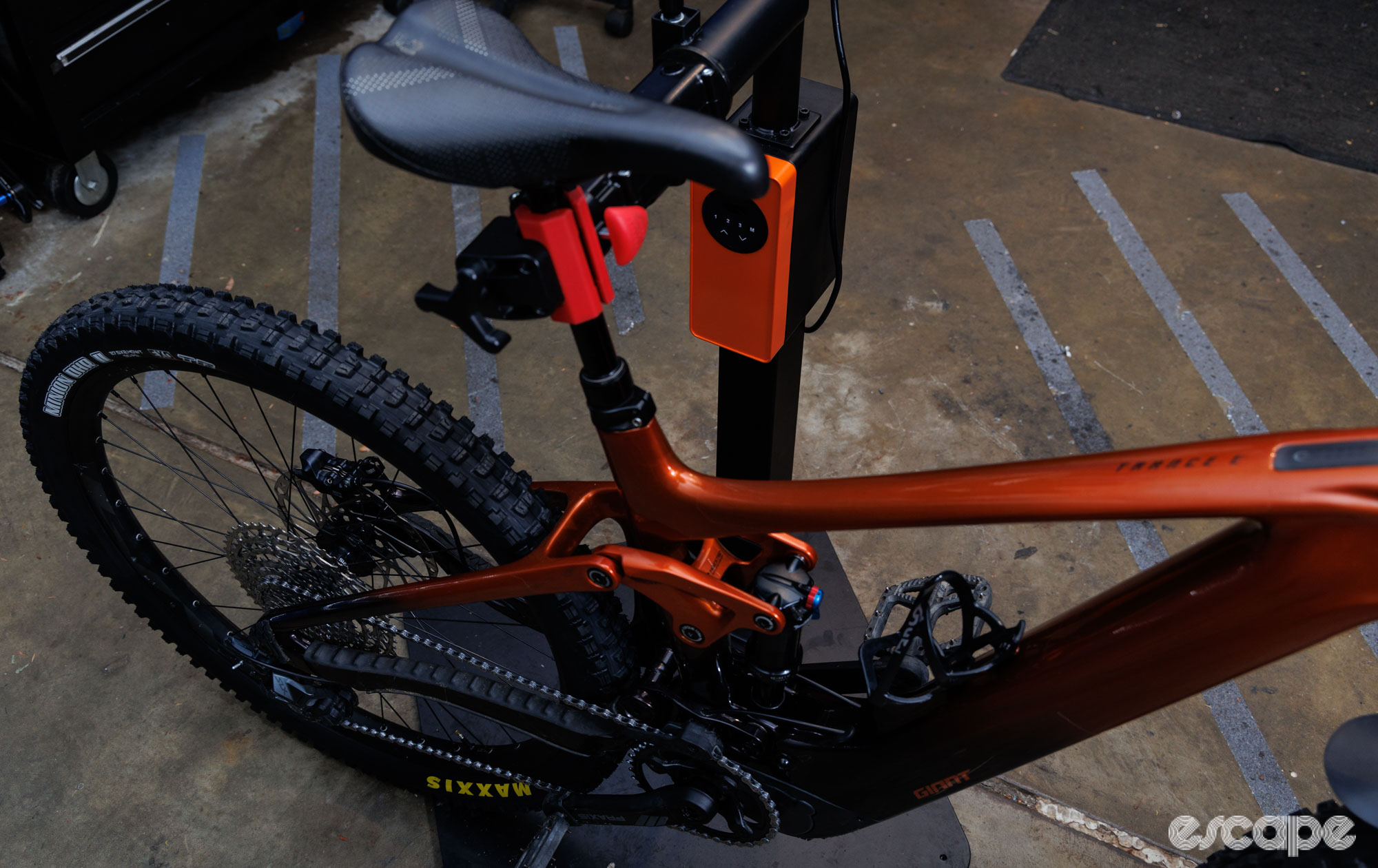
Turning your back to a moving automatic stand does present potential risk and it’s important to note that the Remco doesn’t have any load-sensing capabilities. In this sense, care is needed to ensure the stand isn’t trying to ram the bike into the ground or raise it up against something from above. While the electric motor will theoretically stop well before it breaks a bike, I have found that bottoming out against the ground can cause the steel base to tip up. Watch what you’re doing and you’ll never have an issue.
The only two times I've seen it fault are when I accidentally pulled the plug mid-use and when I eventually overloaded it through multiple cycles while sitting on it (the stand shuts itself off if at risk of overheating). Both times, the stand was quickly brought back by resetting it (done with the front-facing buttons). Overall, the Remco stand's lift-assist functionality is impressively dialled and has shown no signs of issues over my nine-month testing period.
Surprisingly, it’s the simpler elements that leave room for improvement. The aluminium chuck-adapter column seems plenty strong, but it’s not quite as rigid as the steel column of a Park Tool PRS-3 stand. Meanwhile, Remco’s own 2" chuck adapter is another aluminium component that lacks the same holding force and easy clamping of the equivalent Park version (which can be fitted to the Remco adapter). Plus, Remco uses aluminium wedges to clamp onto the workstand’s clamp, and those are proving less durable than Park Tool’s steel wedges.
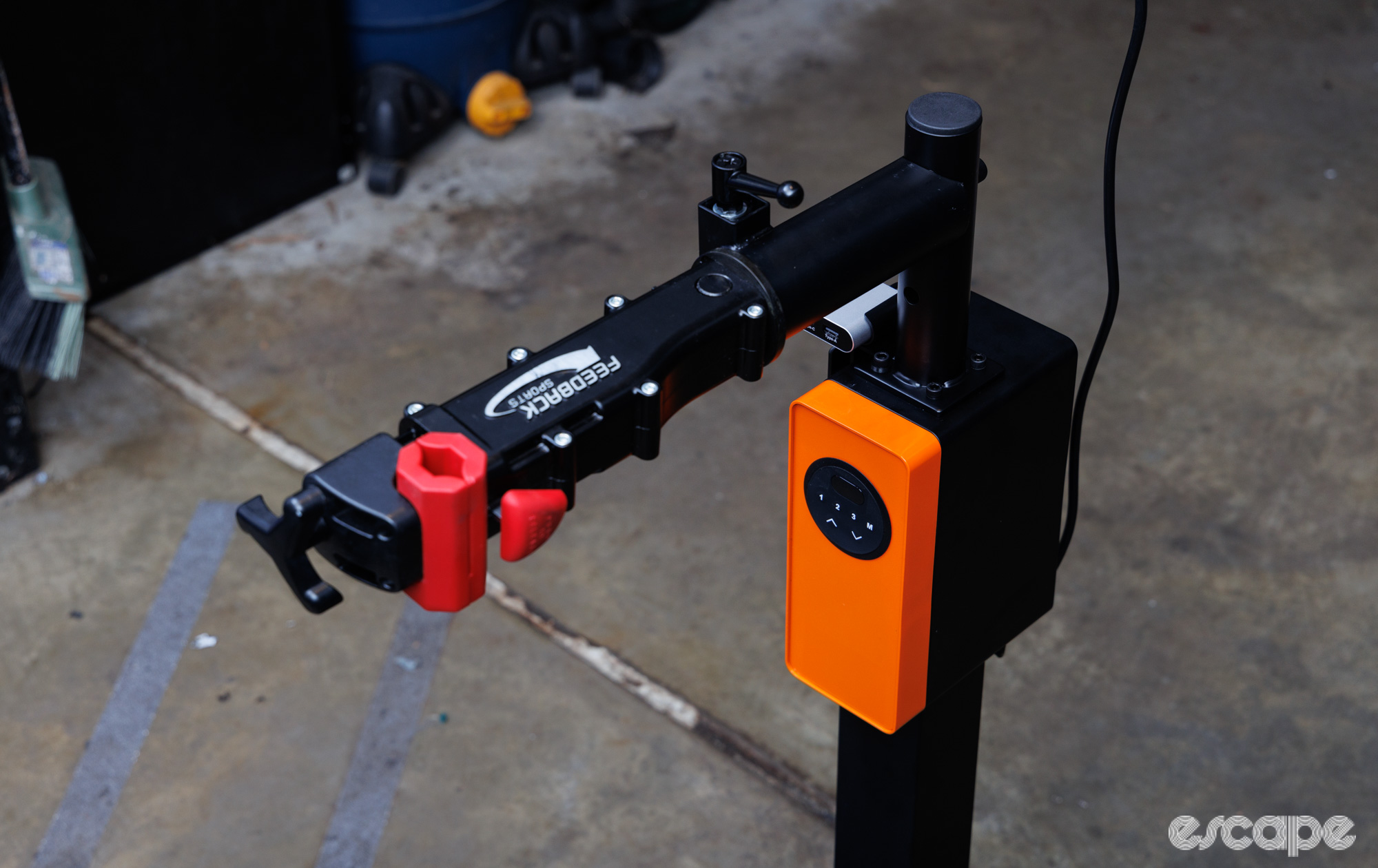
When not moving, the stand feels just as stable as something like the Park Tool PRS-3. Here, you have a workstand that feels solid under load, doesn’t let the bike bounce around much, and feels vastly superior to a lightweight folding stand. And as already mentioned, the Remco doesn’t need to be plugged in to use it, only if you want to adjust its height.
My best experience with this stand was reached once I used the steel 2" chuck adapter from a Park Tool PRS-3 stand (these parts also exist as spares from Park Tool). Not only does this offer more-efficient and easier clamping force, I also prefer the flip-type handle that Park provides when adjusting the bike’s angle (it’s especially beneficial with the EVT Right Arm clamp). Speaking of Park Tool, I also borrowed the aluminium tool tray off of my old PRS-3 stand which fit perfectly onto the Remco clamp adapter.
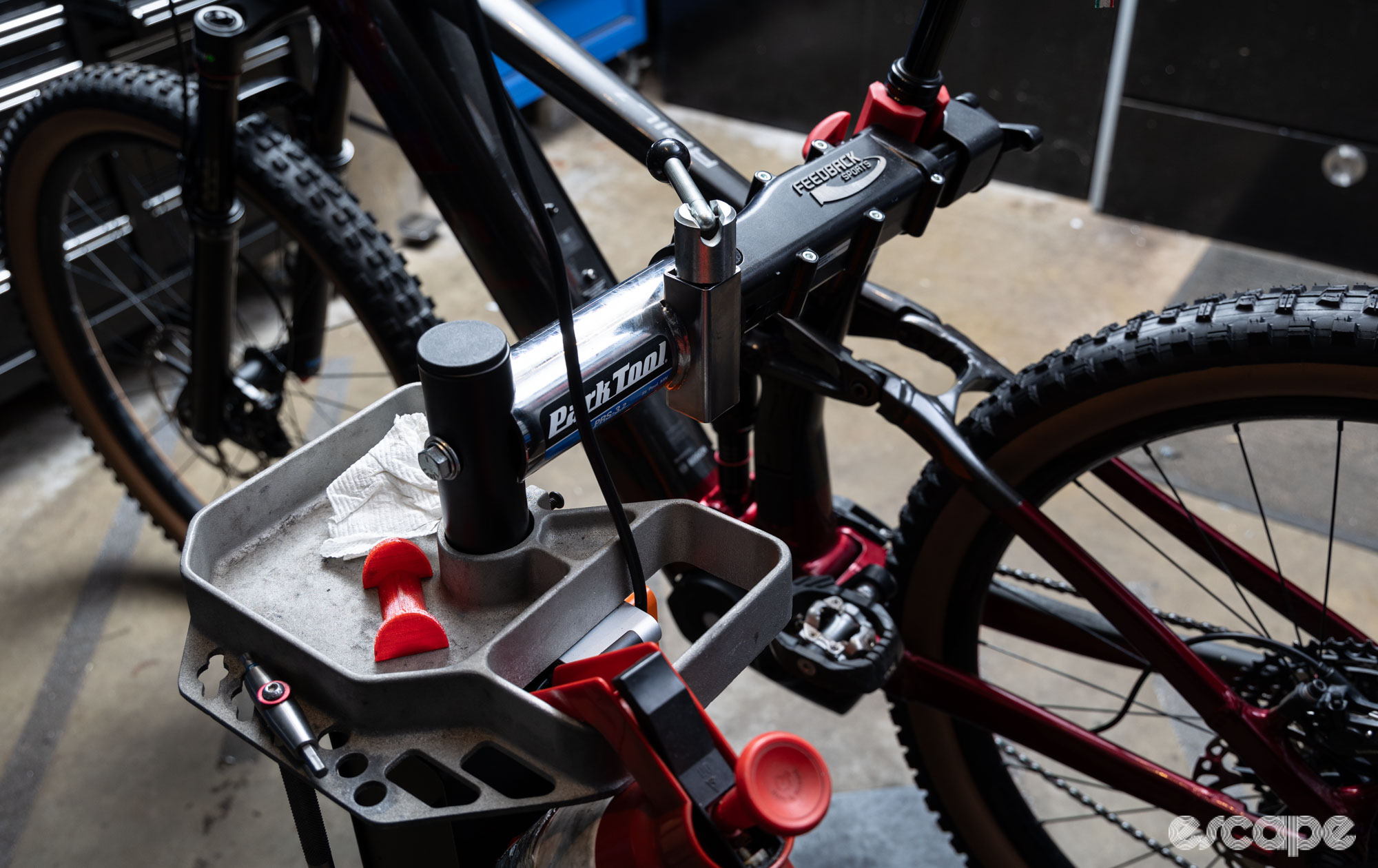
Using Park Tool’s 2" chuck adapter (aka, #124A horizontal tube) did introduce a very minor amount of movement with Remco’s upright column. It’s not enough to ever notice it in use, but there is some cosmetic wear that shows some movement under extreme pressure is present. Otherwise, it was bliss.
I’m optimistic that Remco will improve on these areas in the future (they’re actively working on it), and being external components, any existing owners of these stands will be easily able to make the upgrade when they become available. In the meantime, you can make Remco’s own chuck adapter a pro-level item by equipping Park Tool’s clamping wedges and handle.
Others to consider
The world of workstands and repair stands offers countless options across a wide range of price points. At the professional level, there are folding workstands (such as the Feedback Sports Pro Mechanic and Park Tool PCS-26) made for easy storage and portability, fixed workshop stands like the Park Tool PRS-3.3-2, and a growing wave of assisted-lift stands.
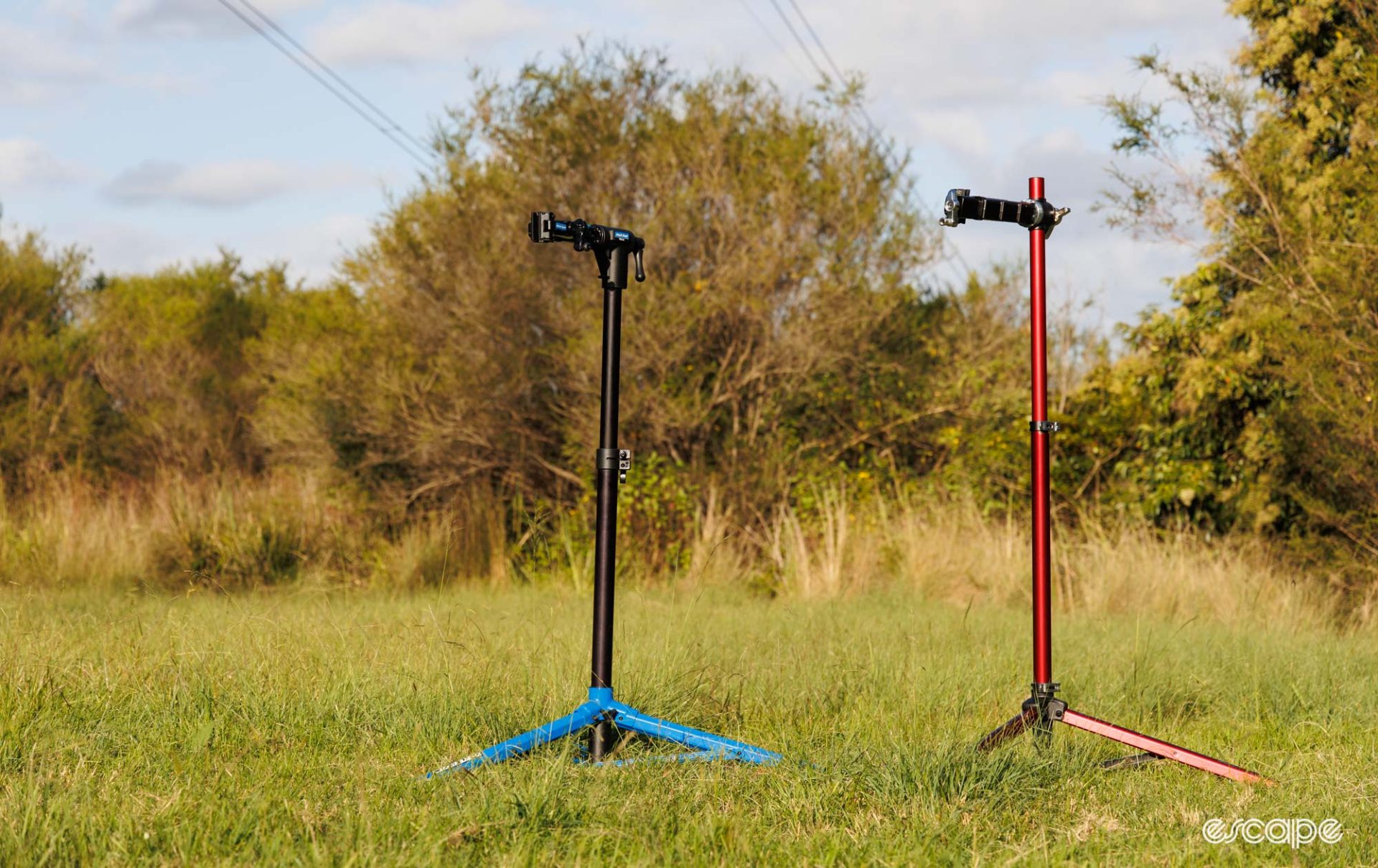
While Remco leads the way in making electric-assist stands more affordable, they’re soon to have competition from Feedback Sports which recently announced its upcoming Pro E-Lift stand (US$1,195). This stand seems to introduce a more easily moved design and a power cord that stays at the base, but also runs into the same minimum height limitations as the Remco.
Also playing in a similar space is the Topeak Prepstand eUp Pro (US$950). This one is effectively a giant dropper seatpost and provides 17 kg (35 lbs) of assisted lifting from a sealed nitrogen gas cylinder that’s controlled via a foot pedal. My brief playing with this one left me wanting something that held the bike more solidly, went lower than it does, and felt more like a pro-level product. Still, it’s currently the only folding assisted-lift standing on the market.
Then there are the heavier-duty options for where space and budget allows. The first on that list is EVT’s Ez-Lift (starting from US$2,600). This stand is free from anything that needs to be plugged in or could wear out, and rather achieves its lift-assist with a choice of an 8.5 or 16 kg counterweight. It’s a brilliantly smooth and functional stand that I quite simply love. Still, with e-bikes bikes only getting more popular and heavier, even the newer and heavier counterweight option may not be enough for some.
In a similar vein, there is the Italian company Bicisupport which now offers a counterweight-based stand like the EVT and another that is pneumatically assisted (air compressor). Pricing is TBC on these.
As seen at the Sea Otter Classic earlier this year, Spanish-based Ezoord has a stand that in some ways looks like Remco’s, but changes up how its controlled and can be powered by a battery for greatly improved mobility (and no cord to trip over). The company even has a stand with a lifting capacity of up to 80 kg (176 lb). Prices on these are only available on enquiry.
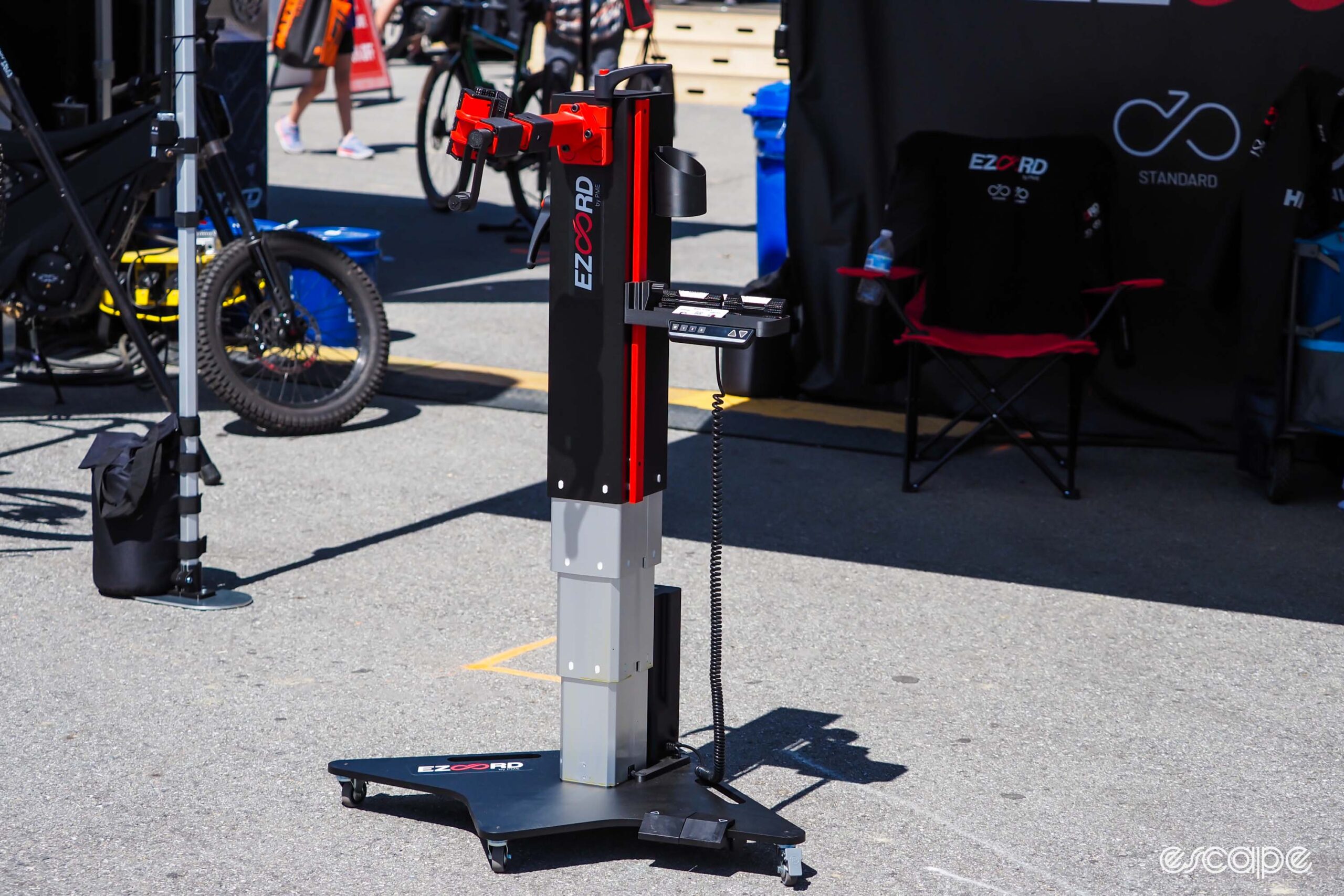
That gets us into the tough-to-move options from Park Tool, VAR, and Unior. There are highs and lows to each (pun intended), and each aims to solve various different limitations of the others. I’ll leave that research to you, but certainly do consider how important mimimum/maximum height ranges are to your workshop and the ceiling height you have available to make the most of that. For example, the popular Park Tool PRS-33.2 costs US$2,390 and stands at 237 cm / 93", but can be cut down shorter at a cost to the adjustment range. And while the Remco claims zero service is needed, a lot of these other professional stands do come with suggested service intervals and a more limited warranty (Park Tool is just one year).
Lastly, I’ve also seen some truly ingenious self-made adjusting workstands that borrow concepts from various other stands. Some are built on 80/20 extrusions and use counterweights (like EVT’s stand), others integrate electric motors, and I’ve even seen a few take the pneumatic (air) path.
Wrap up
For dedicated home mechanics and professionals alike, the Remco Bike Lift offers a whole lot of stand for a very reasonable price. I now know a number of shops and service shops that have bought into the Remco stand and are stoked on it.
Busy professional workshops dealing with hefty long-wheelbase cargo bikes will likely still want to spend more for something that’s designed for lifting such things, but for most other applications the Remco Bike Lift will make light work of the situation. It’s not perfect, but it’s truly impressive how simple Remco has made the function and ownership of this product. It’s a healthy reminder that the cycling world can still learn (and borrow) plenty from some more mainstream consumer product categories.
Did we do a good job with this story?




